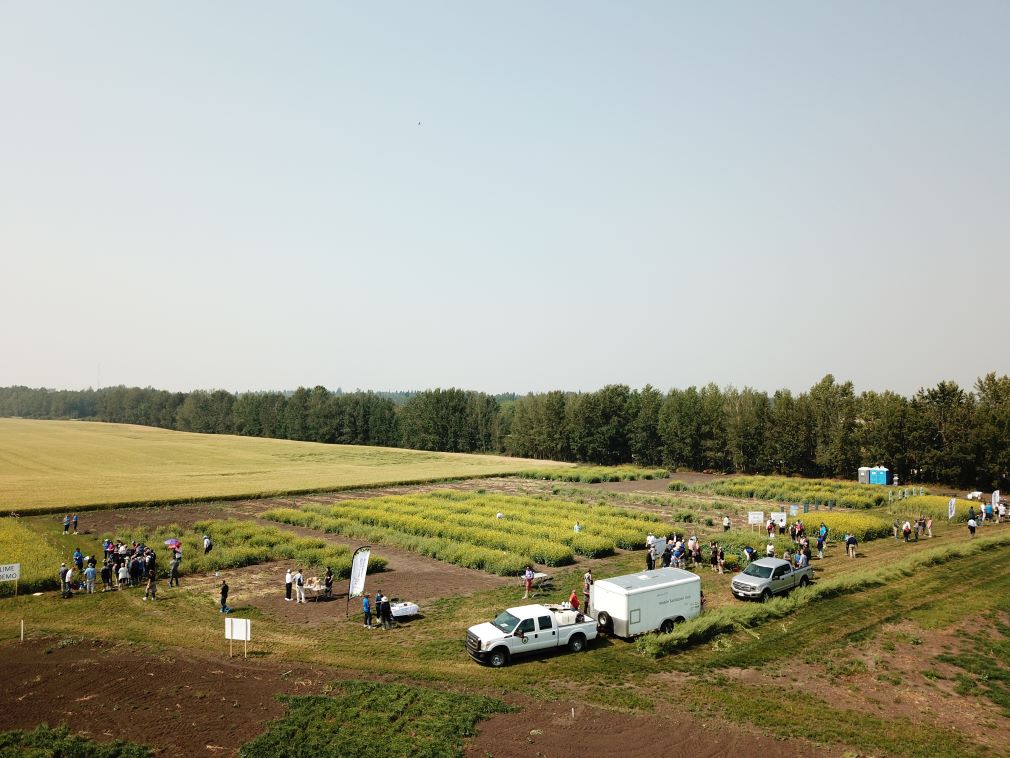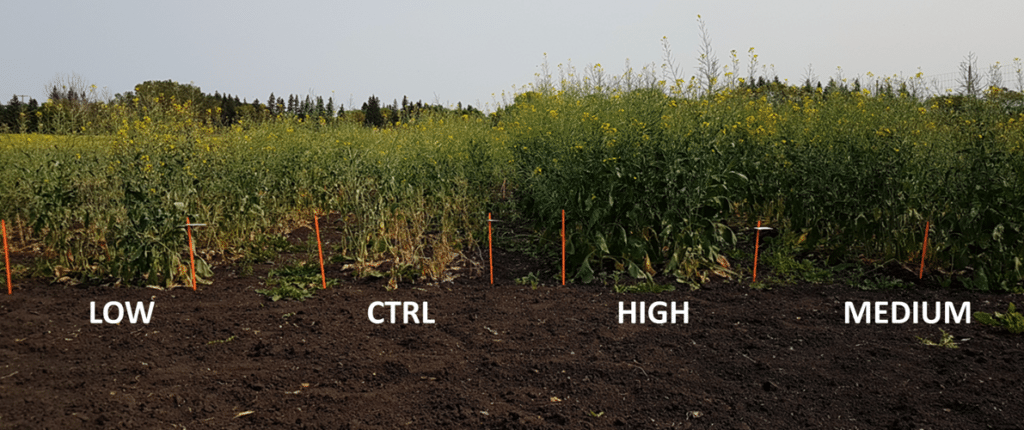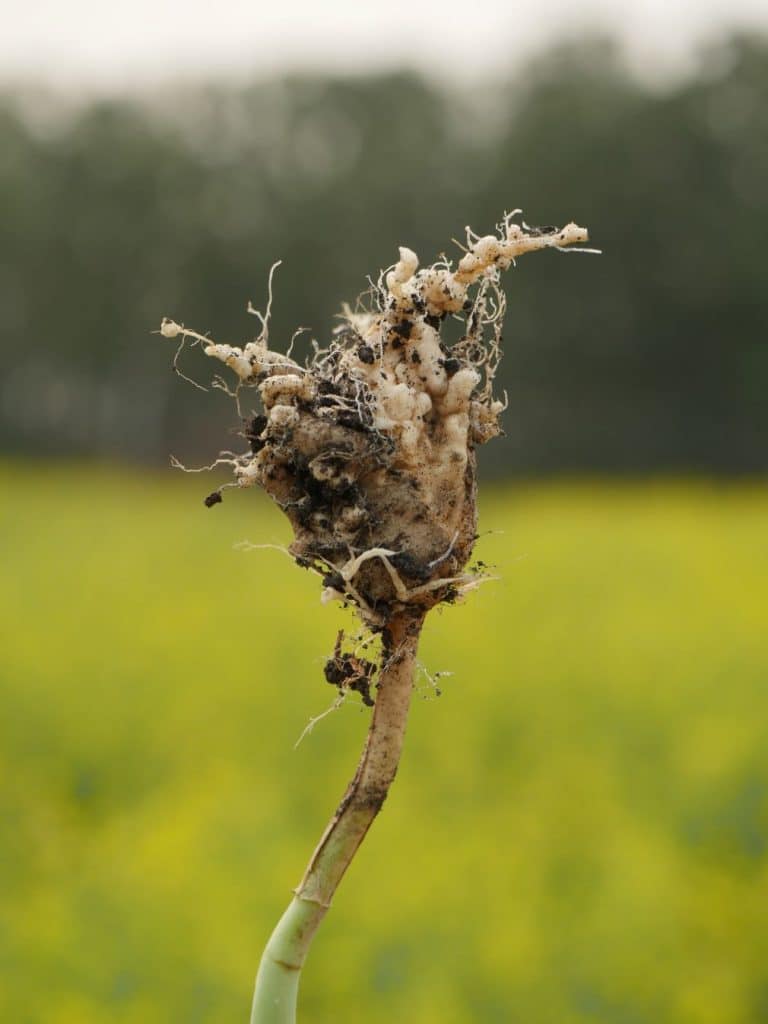Key Result
A study of integrated management practices to manage clubroot show a benefit from hydrated lime treatments, particularly for clubroot-susceptible cultivars.
Project Summary
The goal of this project is to develop management practices to reduce clubroot spore populations and prevent their buildup in at-risk areas. These practices are necessary to protect genetic resistance in canola varieties.
Specific project objectives are to:
- Characterize soil properties and pathotypes in clusters where resistance has been defeated.
- Test field pre-treatment and amendment techniques, including liming under varying spore concentrations and liming field entrances prior to clubroot introduction.
- Quantify yield loss in relation to disease severity.
- Assess the effect of cultivar rotation on clubroot pathotype structure.
- Screen clubroot-resistance canola varieties against novel clubroot pathotypes.
This study complements the efforts of Canadian Canola Clubroot Cluster Pillar 2: Developing novel resistance resources and strategies to address the new threat of clubroot canola production on the Prairies and Canadian Canola Clubroot Cluster Pillar 3: Host-pathogen biology and interaction.
Research activities
This research project is made up of multiple studies or research activities, which are led by different researchers, as provided below.

- Characterization of soils and pathotypes in clusters where resistance breakdown has occurred (led by Hwang and Strelkov)
- Field pre-treatment and soil amendment techniques (led by Hwang and Strelkov)
- Integrated clubroot management methods (led by Hwang, Strelkov, Gossen, and McDonald)
- Development of yield loss model related to clubroot severity (led by Hwang and Strelkov)
- Effect of the soil environment on clubroot development (led by Hwang and Strelkov)
- Effect of cultivar rotation on clubroot pathotype structure (led by Strelkov and Hwang)
- Disease nursery and resistance screening (led by Hwang and Fredua-Agyeman)
- 2018 International Clubroot Workshop (Entire Team)
Outcomes
The utility of genetic resistance as a clubroot management tool is at risk. The entire zone infested by clubroot is susceptible to resistance breakdown and every commercially available clubroot-resistant genotype of canola is potentially susceptible to novel clubroot strains. Deployment of resistant canola varieties must be combined with other clubroot management strategies. This project explored various strategies, including lime, canola cultivar rotation and perennial grasses.
Hydrated lime (not limestone) can work
Researchers conducted field and greenhouse trials to study the effects of lime amendments to soil. For the field trials (at the Crop Diversification Centre North, Edmonton), researchers spread three rates of hydrated lime and seeded a susceptible canola cultivar. Rates were low (1.9 tonnes per acre), medium (3.2 t/ac.) and high (4.6 t/ac.).

At the first field site, untreated control blocks had a pH of 5.6. The highest lime treatment increased pH to 7.8 at the time of seeding. This high rate reduced the clubroot disease severity index by 91 per cent at eight weeks after planting and by 71 per cent at harvest time. The high rate increased yield by 13 per cent. At the second field site, untreated control blocks had a pH of 5.5. The highest lime rate increased soil to a pH of 7.7 at the time of seeding. The high rate reduced the clubroot disease severity index by 45 per cent at eight weeks after planting and 50 per cent at harvest time. Yield increased 343 per cent.
For greenhouse trials, researchers inoculated potting soil with four different populations of P. brassicae spores, then treated the soil with “zero grind” limestone or hydrated lime at rates equivalent to 4.7, 8.1, 11.4 and 14.8 tonnes per hectare of lime. These rates adjusted the pH to 6.0, 6.5, 7.0 and 7.5, respectively. Eight weeks after inoculation, disease severity indices were 92-100 per cent and nine-13 per cent, respectively, in the susceptible and resistant controls (no lime) treatments. The index of disease decreased to zero per cent in both the susceptible and resistant cultivars following treatment with any of four tested rates of hydrated lime. In contrast, the application of limestone resulted in a modest decrease in clubroot severity and only at the two lowest inoculum levels evaluated.
Researchers also note that when clubroot resistance worked on the clubroot pathotypes present in a field, lime didn’t help yield.
Learn more in the ‘Evaluation of host resistance, hydrated lime, and weed control to manage clubroot in canola‘ paper.
Cultivar rotation
Researchers used a greenhouse study to compare continuous cropping of three treatments: the same susceptible canola cultivar, the same resistant canola cultivar and alternating resistant canola cultivars.
At the end of the first cycle of each rotation, the susceptible cultivar had a disease severity index of highest 91.5 per cent, the resistant cultivar had an index of 78.0 and the resistant rotation had an index of 69.1. Back to back canola increases the risk of clubroot, and CR only helps marginally and for only a short time. After subsequent rotation cycles, disease levels were not significantly different.
Wheat a good rotation crop
Researchers conducted growth room studies to assess the effect of dense seedlings of perennial grasses and conventional rotation crops (wheat, barley, pea and soybean) on resting spores of P. brassicae.
They showed that resting spore concentration declined more quickly in the presence of grass and wheat seedlings than in bare soil. Wheat was as good at reducing spores in soil as perennial ryegrass, but the effect of barley was less consistent, and soybean did not result in any measurable reduction relative to bare soil.
Additional publications resulting from this research
Effect of clubroot (Plasmodiophora brassicae) on yield of canola (Brassica napus) – which reported 1% of disease severity index resulted in 0.49% yield loss, under greenhouse conditions, and 0.26% loss in yield, under field conditions. Yield losses were similar across all cultivars tested, but the disease severity tended to be lower in resistant cultivars.
Soil fumigation with Vapam (metam sodium) to control clubroot (Plasmodiophora brassicae) of canola (Brassica napus) – which indicated that clubroot severity decreased the year after the Vapam treatment, potentially due to residual impact or inoculum reduction.






